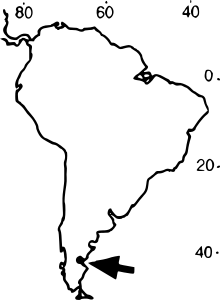Sudamerica
| Sudamerica Temporal range: Paleocene | |
|---|---|
 | |
| Mandible with first and second molars | |
| Scientific classification | |
| Kingdom: | Animalia |
| Phylum: | Chordata |
| Class: | Mammalia |
| Suborder: | Gondwanatheria |
| Family: | Sudamericidae |
| Genus: | Sudamerica Scillato-Yané & R. Pascual, 1984 |
| Species: | S. ameghinoi |
| Binomial name | |
| Sudamerica ameghinoi (Scillato-Yané & R. Pascual, 1984) | |
 | |
| Location of Sudamerica discovery: Punta Peligro, Argentina | |
Sudamerica, literally "South America" in Spanish, is a genus of mammal from the extinct suborder Gondwanatheria that lived in Patagonia, South America during the Paleocene, just after the end of the "Age of Dinosaurs".
Similar to Gondwanatherium, this genus had high-crowned teeth, which are very useful for eating grasses. Since there is no evidence of grass in South America until later, they must also have been effective for other types of food.
Classification
The type specimen of Sudamerica ameghinoi was discovered in Punta Peligro, Argentina in deposits dating to the Lower Paleocene period. In 1999, a near complete lower jaw (dentary) was found.
The genus and species were named by Scillato-Yané and R. Pascual in 1984. The genus is also known by the synonym Sudamericana. The position of gondwanatherians within the class Mammalia is not yet clear.
References
- Scillato-Yané, G.J. & Pascual, R.1985. Un peculiar Xenarthra del Paleoceno medio de Patagonia (Argentina). Su importancia en la sistemática de los Paratheria. Ameghiniana, 21: 316-318.
- Malcolm C. McKenna and Susan K. Bell. (1997) "Classification of Mammals Above the Species Level". Columbia University Press. (ISBN 0-231-11012-X)
- Much of this information has been derived from MESOZOIC MAMMALS: Gondwanatheria, an Internet directory.
| ||||||||||